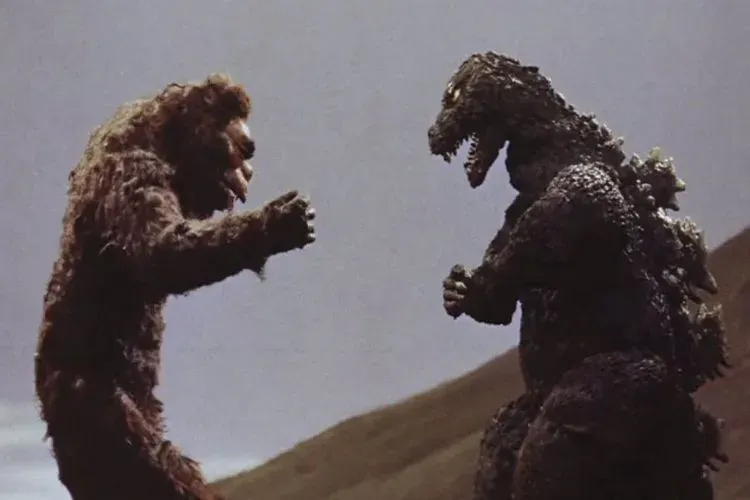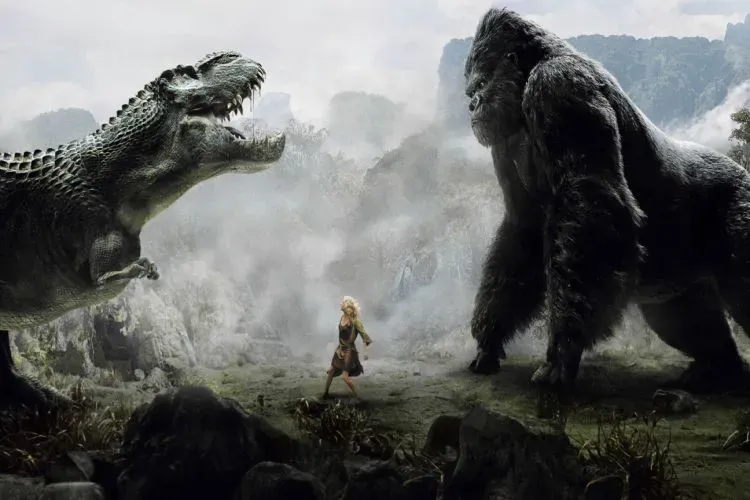King Kong Movies In Order
These King Kong movies in order include different iterations and reboots of most(?) of the Kong movies that have been made and some collaborations with other characters such as Godzilla. From his origin story to versus movies, King Kong has been a household name all throughout these years and is a substantial part of western cinematic culture. Let’s start with the OG Kong movie which was such a gigantic hit back in the 30s.
King Kong (1933)

King Kong is a classic black and white film from 1933 that tells the story of a giant ape who is captured and brought to New York City to be displayed as a freak show attraction. The film follows the ape, Kong, as he escapes from captivity and wreaks havoc on the city, ultimately climbing to the top of the Empire State Building where he is shot down by airplanes.
The film is considered a masterpiece of special effects and is still revered for its groundbreaking stop-motion animation work, which was done by Willis O’Brien and his team. The film also features groundbreaking sound design, including the use of the “screeching monkey” sound effect, which became a hallmark of the film.
The film was directed by Merian C. Cooper and produced by Ernest B. Schoedsack, and it starred Fay Wray, Robert Armstrong, and Bruce Cabot. It was released by RKO Pictures and became a huge commercial success, grossing over $90 million in its initial release (which would be the equivalent of over $1.5 billion today).
King Kong has been remade several times over the years, with versions released in 1976 and 2005, but the original film remains the most well-known and beloved version of the story. It has been selected for preservation in the United States National Film Registry and is considered a classic of American cinema.
Son Of Kong (1933)

Son of Kong is a 1933 American monster adventure film directed by Ernest B. Schoedsack and produced by Merian C. Cooper. It is a sequel to the 1933 film King Kong and follows the story of a small, friendly version of the giant ape who helps a group of humans as they try to escape from an island.
The film was released just nine months after the release of King Kong and was intended to capitalize on the success of the original film. It was produced on a lower budget and with a shorter shooting schedule than the first film, and it received mixed reviews upon its release.
The film starred Robert Armstrong, who also starred in King Kong, as well as Helen Mack and John Marston. The special effects for the film were again handled by Willis O’Brien and his team, who used a combination of stop-motion animation and rear projection to bring the ape character to life.
Despite its somewhat lukewarm reception, Son of Kong has gained a cult following over the years and is considered an important part of film history. It has been released on home video several times and has been screened at various film festivals and retrospectives.
King Kong Vs Godzilla (1962)

King Kong vs. Godzilla is a 1962 Japanese kaiju film directed by Ishirō Honda, with special effects by Eiji Tsuburaya. The film pits the two iconic monsters against each other and is the third film in the Godzilla series, as well as the first film to feature King Kong.
The film follows the story of a pharmaceutical company that captures King Kong and brings him to Japan in an attempt to use him as a promotional tool. However, Kong escapes and encounters Godzilla, who has also been disturbed by the company’s activities. The two monsters begin to fight, causing destruction throughout Japan as they battle for supremacy.
King Kong vs. Godzilla was released in Japan in 1962 and was a huge commercial success, grossing over $2 million at the box office. It was released in the United States in 1963 and was similarly successful, becoming the highest-grossing film in the Godzilla series at the time.
The film is known for its use of suitmation, a technique in which actors wear rubber suits to portray the monsters, as well as its use of special effects, including miniature sets and optical effects. It has been released on home video several times and has been screened at various film festivals and retrospectives. Despite its somewhat campy nature, it is considered a classic of the kaiju genre and has influenced many other films in the genre.
King Kong Escapes (1967)

King Kong Escapes is a 1967 Japanese science fiction film directed by Ishirō Honda and produced by Toho Studios. It is a loose adaptation of the 1933 film King Kong and follows the story of a giant ape named King Kong who is brought to Japan by a mad scientist named Dr. Who, who plans to use Kong’s strength to dig a hole to the Earth’s core.
The film also features a character named Susan Watson, who is sent to Japan by a group called the United Nations Kong Front to stop Dr. Who’s plans. Along with a team of soldiers, Susan helps to defeat Dr. Who and rescue King Kong.
King Kong Escapes was released in Japan in 1967 and was a commercial success, grossing over $1 million at the box office. It was released in the United States in 1968 and received mixed reviews upon its release.
The film is known for its use of suitmation, a technique in which actors wear rubber suits to portray the monsters, as well as its use of special effects, including miniature sets and optical effects. It has been released on home video several times and has been screened at various film festivals and retrospectives. Despite its somewhat campy nature, it is considered a classic of the kaiju genre and has influenced many other films in the genre.
King Kong (1976)

King Kong is a 1976 American monster film directed by John Guillermin and produced by Dino De Laurentiis. It is a remake of the 1933 film of the same name and follows the story of a giant ape named Kong who is brought to New York City from an uncharted island and displayed as a freak show attraction. However, Kong escapes from captivity and begins wreaking havoc on the city, ultimately climbing to the top of the World Trade Center where he is shot down by military helicopters.
The film stars Jeff Bridges, Charles Grodin, and Jessica Lange, with special effects by Carlo Rambaldi. It was released by Paramount Pictures and was a commercial success, grossing over $80 million at the box office.
Despite its financial success, King Kong received mixed reviews upon its release and is considered a campy, over-the-top take on the original film. It has been released on home video several times and has gained a cult following over the years. It was followed by a sequel, King Kong Lives, in 1986.
King Kong Lives (1986)

King Kong Lives is a 1986 American monster film directed by John Guillermin and produced by Dino De Laurentiis. It is a sequel to the 1976 film King Kong and follows the story of a giant ape named Kong who is brought back to life by a team of scientists after being shot down from the top of the World Trade Center.
The film follows Kong as he escapes from captivity and is pursued by a group of military personnel, led by Major Eaton (Brian Kerwin). Along the way, Kong meets a female ape named Lady Kong, and the two fall in love. The film ends with Lady Kong giving birth to Kong’s offspring, implying that the Kong family will continue on.
King Kong Lives was released by De Laurentiis Entertainment Group and was a commercial failure, grossing just $5 million at the box office. It received mostly negative reviews upon its release and is considered a low point in the King Kong franchise. It has been released on home video several times but has not gained the same level of cult following as the original films.
The Mighty Kong (1998)

The Mighty Kong is a 1998 animated film that tells the story of the classic 1933 film King Kong. It was directed by Art Scott and produced by Jerry Beck and features an all-star cast of voice actors, including Jodi Benson, Dudley Moore, and Christian Slater.
The film follows the story of King Kong as he is captured and brought to New York City to be displayed as a freak show attraction. However, Kong escapes and begins wreaking havoc on the city, ultimately climbing to the top of the Empire State Building where he is shot down by airplanes.
The Mighty Kong was released direct-to-video in 1998 and received mixed reviews upon its release. It has since gained a small cult following and has been released on home video several times. Despite its somewhat low budget and campy nature, it is considered a faithful adaptation of the original film and is appreciated by fans of the King Kong franchise.
King Kong (2005)

King Kong is a 2005 American monster adventure film directed by Peter Jackson and produced by Jan Blenkin, Carolynne Cunningham, and Fran Walsh. It is a reimagining of the 1933 film of the same name and follows the story of a giant ape named Kong who is brought to New York City from an uncharted island and displayed as a freak show attraction. However, Kong escapes and begins wreaking havoc on the city, ultimately climbing to the top of the Empire State Building where he is shot down by military planes.
The film stars Naomi Watts, Jack Black, and Adrien Brody, with special effects by Weta Digital. It was released by Universal Pictures and was a critical and commercial success, grossing over $550 million at the box office.
King Kong was praised for its special effects, performances, and faithfulness to the original film, and it won three Academy Awards for its technical achievements. It has been released on home video several times and is considered a classic of the monster film genre.
Kong: Skull Island (2017)

Kong: Skull Island is a 2017 American monster film directed by Jordan Vogt-Roberts and produced by Thomas Tull, Mary Parent, and Jon Jashni. It is a reimagining of the King Kong franchise and serves as an origin story for the giant ape.
The film follows a group of scientists and soldiers who travel to an uncharted island in the Pacific called Skull Island, where they encounter Kong and a variety of other monstrous creatures. As they try to survive on the dangerous island and find a way to escape, they also uncover the secrets of Kong’s past and the island’s history.
Kong: Skull Island stars Tom Hiddleston, Samuel L. Jackson, Brie Larson, and John C. Reilly, with special effects by Industrial Light & Magic. It was released by Warner Bros. and was a commercial success, grossing over $565 million at the box office.
The film received generally positive reviews upon its release and was praised for its special effects, action sequences, and performances. It has been released on home video several times and is considered a successful reboot of the King Kong franchise.
Godzilla Vs Kong (2021)

Godzilla vs. Kong is a 2021 American monster film directed by Adam Wingard and produced by Mary Parent, Alex Garcia, and Eric McLeod. It is a crossover film that pits the two iconic monsters against each other in a battle for supremacy.
The film follows the story of Godzilla and Kong as they are brought into conflict by a mysterious organization that wants to pit the two monsters against each other. As they fight, they also encounter a variety of other monstrous creatures and face off against a group of human villains who want to use their powers for their own gain.
Godzilla vs. Kong stars Kyle Chandler, Alexander Skarsgård, Millie Bobby Brown, and Zhang Ziyi, with special effects by Industrial Light & Magic. It was released by Warner Bros. and was a critical and commercial success, grossing over $1 billion at the box office.
The film received generally positive reviews upon its release and was praised for its special effects, action sequences, and performances. It has been released on home video several times and is considered a successful entry in both the Godzilla and King Kong franchises.
Conclusion
King Kong movies will always be part of cinematic history and have been given lots of interpretations, both simple and complex, by a lot of fans and critics. For most regular folks like us, it has been part of our childhood imaginings of what a giant ape running around the city wreaking havoc looks like.
The King Kong movies seem to have picked up steam and the franchise isn’t going away yet. The monsterverse series has breathed new life into the Kong franchise and expect more and bigger movies to come in the future.



